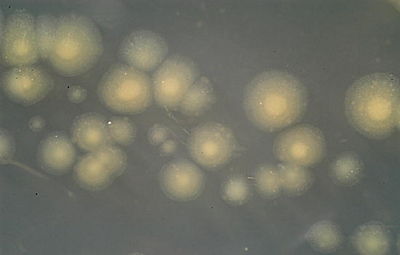Arbuscular mycorrhizae
Template:Arbuscular mycorrhizae

Classification
Eomycota
Domain:
Glomermycota
Phylum:=
Glomeroycetes
Order:=
Archaeosporales
Family:
Ambisporaceae
Genre:
Ambiospora
Family:
Archaeosporaceae
Genre:
Archaeospora Intraspora
Family:
Geosiphonaceae
Genre:
Geosiphon
Order:
Diversisporales
Family:
Acaulosporaceae
Genre:
Acaulospora Kuklospora Acaulospora
Family:
Entrophosporaceae
Genre:
Entrophospora
Family:
Gigasporaceae
Genre:
Gigaspora Scutellospora
Family:
Pacisporaceae
Genre:
Pacispora
Order:
Glomerales
Family:
Glomeraceae
Genre:
Glomus
Order:
Paraglomerales
Family:
Paraglomaceae
Genre:
Paraglomus
Species:
Currently, the named species of arbuscular mycorrhizae fungi number over 200, but it is believed that there are over 2500 species which have not been identified as of yet (Martin et al, 1994).
Alternate names:
The term "vesticular- arbuscular mycorrhiza (VAM) was previously used to describe these fungi. However, because members of the Gigasporaceae do not form vesicles, "arbuscular mycorrhiza" is now a more widely accepted term.
|
NCBI: Taxonomy Genome: R. denitrificans R. sp. MED193 |
Description and Significance
Arbuscular mycorrhizae are symbiotic relationships between specialized soil fungi and plant roots. The relationship between the plants and the fungi benefit the fungi and the plants by raising the quality of the soil and providing more access to available nutrients to each. Arbuscular mycorrhiza greatly improve the rate of growth in plants, especially in less than optimal conditions for plant growth. The extensive hyphal networks which the mycorrhiza form aid in the plants ability to access water and nutrients from the soil.
Arbuscular mycorrhizae are present and aid the growth of over 80% of plants species. They are present on all continents except for Antarctica. Many of the crop plants which are grown in current agricultural practices are aided by arbuscular mycorrhizae, and studies are being conducted to explore methods to improve yields through the inoculation of the crops with arbuscular mycorrhizae.
The extensive extaradical mycelium which the arbuscular mycorrhizae forms is responsible for extending the host plant's rooting network, providing a larger area with which to gain nutrients and water. The fungus invades the plant's root cells, expands it's mycelium which gains nutrients and provides them to the plant's cell, reproduces, then dies. The life cycle of the mycorrhizae cell is usually between 4 and 15 days, and when the fungus dies, the plant cell returns to normal (Moore, 2017).
Genome Structure
Arbuscular mycorrhizae form endosymbiosis with many plants and are simultaneously hosts to Mollicutes/ Mycoplasma related endobacteria [(Sun et al., 2018)]. Although they are very significant, genome information for arbuscular mycorrhizae and their Mycoplasma related endobacteria is currently sparse [(Sun et al, 2018)]. It is thought, however, that the evolution of arbuscular mycorrhizae and the colonization of land plants over 353- million years ago coincided, and that the mycorrhizae became more specialized to the plants where it formed [(Moore, 2017)].
Cell Structure and Metabolism
The most significant part of the cell structure of the arbuscular mycorrhizae is it's tree-like hyphal structures, known as its arbuscules, which deliver minerals and nutrients to its host plant. These nutrients are accepted by the host plant through a "plant derived periarbuscular membrane which surrounds the fungi's hyphae" and directs nutrients to the plant
Roseobacter can have major implications for turnover of organic material in the ocean as they consume decomposing organisms, also known as marine snow (phytoplankton or organic "aggregates". They freely swim throughout the water until they find a particle to colonize.
It has been suggested that Roseobacter bacteria benefit from association with dimethylsulfoniopropionate (DMSP)-producing dinoflagellates because of the high metabolic rate at which Roseobacter can degrade them. The result of such associating is the use of both lyase and demethylation pathways (Miller).
Roseobacter can be found in pure culture.
Ecology
Roseobacter strains have been found in a variety of places including the Mediterranean and New England. One of the most striking feature of Roseobacter is the exceptional amount of variation between the strains in the different locations in which Roseobacter has been identified. One potential cause for concern is the number of unconfirmed strains that have been identified as of the Roseobacter species, which could lead to incorrect information if wrongly indentified.
Pathology
A strain of Roseobacter(deemed R. crassotreae) has been identified as an oyster pathogen leading to a disease called Juvenile Oyster Disease (JOD), severely affecting oysters in New England. What is most concerning about this recent increased mortality rate is the discovery of Roseobacter strains in apparently healthy oysters up a week prior to the outbreaks. Roseobacter has been affecting oysters older than two years (Boettcher).
